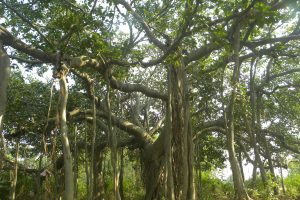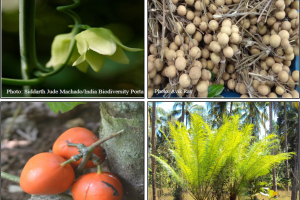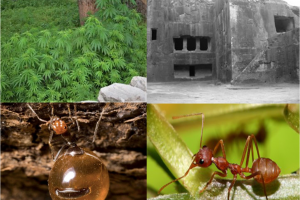EDITORIAL
It’s March ….Mercury is slowly rising….winter garments are stacked back….a sudden glance offers a sweet shock-… our green neighbors surprisingly shed off all the leaves just to show their pride possession of blood red flowers…. The prodigal Bombax ceiba, commonly known as red silk cotton (English), Semal (Hindi), and adored in many other regional names. Likewise, this is the time for Butea monosperma (flame of the forest), Spathodia campanulata (African tulip tree) all with red and orange flowers vibrate our rural and urban landscape with energy and spontaneity. Imbued with this vivacity, CEiBa Newsletter is bringing the colorful vibration to all our readers through its collage of articles, snippets and other newbie.
sweet shock-… our green neighbors surprisingly shed off all the leaves just to show their pride possession of blood red flowers…. The prodigal Bombax ceiba, commonly known as red silk cotton (English), Semal (Hindi), and adored in many other regional names. Likewise, this is the time for Butea monosperma (flame of the forest), Spathodia campanulata (African tulip tree) all with red and orange flowers vibrate our rural and urban landscape with energy and spontaneity. Imbued with this vivacity, CEiBa Newsletter is bringing the colorful vibration to all our readers through its collage of articles, snippets and other newbie.
Resonating with the bright flowering trees, our article section starts with ancient trees. They are the mighty giants of the past, speechless witness of historical events, shelters for many lives, support for daily activities and are helpless in front of ever-growing demands of human society. The article depicts this multi-spectrum existence of old trees and seeks our attention and sensitivity towards them. Our next article introduces us with wetland based nutritional food “Makhana”. Starting from Jammu and Kashmir, this plant is now widely distributed across northern and north-eastern states of India. The high calorific value of its edible seed promoted steady increment of its market value. This article explores the status of Makhana cultivation and the possibilities to improve the village economy in northern West Bengal. A more general and global topic on climate has been discussed in our third article with an aim to introduce our readers with the climatic history of the earth and its seminal role in shaping biodiversity. A reading will reveal, the understanding of global warming and its impact on the earth is incomplete without knowing the climatic history.
We introduce a new section on ‘ wild uncultivated edible plants of India’ from this issue. A plethora of uncultivated species fills up our stomach and infuses support to our food system. We invite our readers to browse the lesser-known food plants and their different usage among the distant communities. We anticipate that this series will sensitize our readers about the diversity of food types and food resources assimilated in our socio-cultural fabric.
Lastly, but like garnishing the dish, we have nice snippets. There are Cannabis the heritage keeper, honeypot and weaver ants, and fish as an emblem for royal practices. So, it’s time for happy reading hours.
RAJASRI RAY
ARTICLES
Ancient trees: conserving living heritage for posterity
The Mallanimli Baobab of Orchha, India, the great Banyan tree of Kolkata Botanical Garden, the giant red woods of California, the ancient Ginkgos in China, the mighty dipterocarps in Malaysia or the eucalypts piercing the Australian landscapes, all these trees keep mesmerizing us not just by their larger than life presence, but also by their ancient links with our forefathers. These widely known woody giants not only instigate our romanticism about…
Nutritional potentiality of Makhana cultivation in wetlands and water body of India
Mothers and grandmothers are worried about the health of the children, there are continuous discussions on how to develop a healthy diet for them, there are endless discussions during pregnancy what to eat and what not, so that both mother and baby will be physically fit. Similarly, work-loaded people are looking for some good options to keep themselves stress-free and full of energy. Above all, profit-driven business groups also formulate new recipes…
Last Ice Age: understanding Earth’s climatic history
With the threat of global warming and unpredictable climate looming over our heads, it is imperative that we understand the past climatic history of our planet to make any predictions about the future. Earth has had a violent climatic past, undergoing repeated warming and cooling phases. A long period of global cooling is known as an ice age. Earth has faced at least five major ice ages characterized by periods of global…
WILD UNCULTIVATED EDIBLE PLANTS OF INDIA
Wild uncultivated edible plants of India
Kalasin Province, the largest and poorest part of Thailand, is located in the Korat Plateau. In a sleepy village of the province, Watcharapong wakes up in one early morning, goes out to the forest to grab some Phak saap or Nang noon (local passion fruit – Adenia viridiflora) from a nearby tree of the forested patch. These give him vital support during his untimely hunger pangs. Fresh harvest from the plant is…
GLIMPSES OF NATURE AND CULTURE
Glimpses Of Nature And Culture
Cannabis sativa: The keeper of heritage The word “Cannabis” is not familiar to us except those who are accustomed with plants and narcotic products. However, by hearing its popular name “Ganja” or “Bhang” we can almost immediately relate ourselves with the intoxicated hallucinogenic liquid, which many of us tested during festivals. Although it has many other uses around the globe the plant as a construction material is something worthy of mention. Cannabis…





